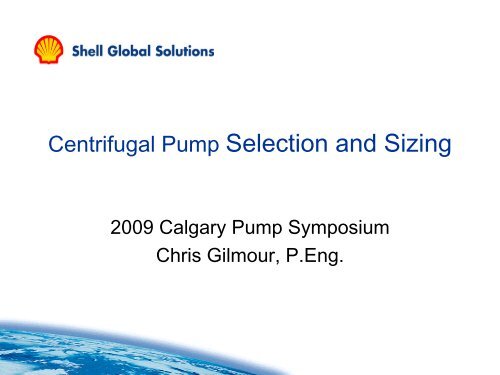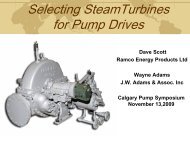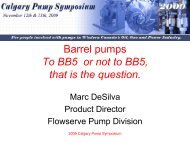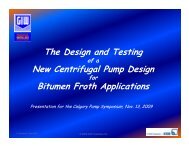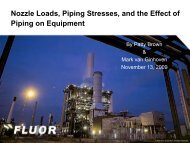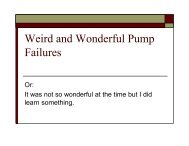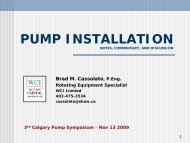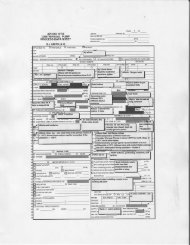Centrifugal Pump Selection and Sizing - Calgary Pump Symposium ...
Centrifugal Pump Selection and Sizing - Calgary Pump Symposium ...
Centrifugal Pump Selection and Sizing - Calgary Pump Symposium ...
You also want an ePaper? Increase the reach of your titles
YUMPU automatically turns print PDFs into web optimized ePapers that Google loves.
<strong>Centrifugal</strong> <strong>Pump</strong> <strong>Selection</strong> <strong>and</strong> <strong>Sizing</strong><br />
2009 <strong>Calgary</strong> <strong>Pump</strong> <strong>Symposium</strong><br />
Chris Gilmour, P.Eng.
<strong>Pump</strong> types being Considered<br />
• One <strong>and</strong> two stage centrifugal pumps<br />
- OH2, OH3/4, BB1, BB2<br />
- most common pumps used<br />
• <strong>Pump</strong>s not considered in this<br />
presentation:<br />
- OH5 close-coupled VIL<br />
- OH6 high-speed integral gear VIL<br />
- vertically-suspended pumps<br />
- multi-stage centrifugal pumps<br />
- low-flow pumps (Ns < 500)<br />
2
<strong>Pump</strong> types – Vertical In-line <strong>Pump</strong><br />
3
<strong>Pump</strong> types – Horizontal Overhung<br />
4
<strong>Pump</strong> types – Between-Bearing <strong>Pump</strong><br />
(radially split)<br />
5
<strong>Pump</strong> types – Between-Bearing <strong>Pump</strong><br />
(axially split)<br />
6
<strong>Pump</strong> <strong>Selection</strong> – Old School<br />
7
<strong>Pump</strong> <strong>Selection</strong><br />
8
The Goal<br />
• We want to select <strong>and</strong> purchase pumps that<br />
are:<br />
- Reliable<br />
- Reasonably priced<br />
- Efficient<br />
9
What type of plant?<br />
• Class of Plant<br />
- Class 1 : low first cost, lower on-stream factor<br />
- Class 2: a Class 1 plant with selective upgrades<br />
- Class 3: higher first cost, higher on-stream factor<br />
• Construction (wrt pumps)<br />
- Modularized or not modularized<br />
10
<strong>Pump</strong> <strong>Selection</strong> – order of preference<br />
• 1. Vertical inline pump<br />
• 2. Horizontal Overhung <strong>Pump</strong><br />
• 3. Between Bearing <strong>Pump</strong><br />
11
<strong>Pump</strong> <strong>Selection</strong><br />
• The smallest, least expensive, most<br />
efficient pump is an overhung pump<br />
(vertical inline, or horizontal overhung)<br />
running at 3600 rpm<br />
- higher speed = smaller diameter for same head<br />
- higher speed = higher Ns = higher efficiency<br />
- smaller diameter = smaller casing size = less $<br />
12
Relative Costs – example 1<br />
• 200 m3/h @ 150 m w/ >7m NPSHa (880<br />
gpm @490 ft w/ > 23 ft NPSHa)<br />
- 150 HP motor, single seal<br />
Pum<br />
p<br />
size rpm eff rel $ + Install $<br />
OH3 4x6x13 3600 78% 1.00 base support<br />
OH2 4x6x13 3600 78% 1.35 + fdn, grouting<br />
BB2 4x6x13 3600 70% 2.30 +fdn, grouting<br />
13
Relative Costs – example 2<br />
• 200 m3/h @ 150 m w/ 4m NPSHa (880<br />
gpm @490 ft w/ 13 ft NPSHa)<br />
- 150 HP motor, single seal<br />
Pum<br />
p<br />
size rpm eff rel $ + Install $<br />
OH3 6x8x23 1800 66% 1.00 base support<br />
OH2 6x8x23 1800 66% 1.07 + fdn, grouting<br />
BB2 4x6x13 3600 70% 1.04 +fdn, grouting<br />
14
Relative Costs – example 3<br />
• 200 m3/h @ 150 m w/ 4m NPSHa (880<br />
gpm @490 ft w/ 13 ft NPSHa)<br />
- 150 HP motor, dual seal w/ Plan 53a<br />
Pum<br />
p<br />
size rpm eff rel $ + Install $<br />
OH3 6x8x23 1800 66% 1.00 base support<br />
OH2 6x8x23 1800 66% 1.06 + fdn, grouting<br />
BB2 4x6x13 3600 70% 1.33 +fdn, grouting<br />
15
Why not always buy a 3600 rpm O/H<br />
pump?<br />
• An O/H pump is not always available in<br />
the size required<br />
• An O/H pump is not always an<br />
appropriate selection<br />
• 3600 rpm may not be an appropriate<br />
speed for the process conditions<br />
16
Overhung <strong>Pump</strong>s – Typical Coverage<br />
<strong>Pump</strong> Impeller Diameter (inches)<br />
Size<br />
(Dis x Suc) 7 9 11 13 15 17 20 23 27 30 *<br />
1-1/2x3 2<br />
2x3 2 2,4 2,4 2,4<br />
3x4 2 2,4 2,4 2,4 2,4<br />
4x6 2 2,4 2,4 2,4 2,4 4,6 4,6<br />
6x8 2,4 2,4 2,4 2,4 4,6 4,6 4,6 4,6<br />
8x10 4 4,6 4,6 4,6 4,6<br />
10x12 4,6 4,6 4,6 4,6<br />
12x16 3600 rpm (2-pole) 4,6 4,6 4,6 6<br />
16x20 * 1800 rpm (4-pole) 4,6 6<br />
20x24 * 1200 rpm (6-pole) 6<br />
* OH2 only<br />
17
Overhung <strong>Pump</strong>s – Typical Limits<br />
• Tip Speed<br />
- u = RPM/60 x PI x Diameter , units – m/s, m<br />
- Issue is vibration<br />
- Typical limit is 62 m/s (205 ft/s) for Class 3 plant<br />
- 13” diameter impeller at 3550 rpm<br />
- 27” diameter impeller at 1750 rpm<br />
- Consider increasing for Class 1 plant<br />
18
VIL <strong>Pump</strong>s – Typical Limits<br />
• Tip Speed: issue is vibration<br />
- Typical limit is 62 m/s (205 ft/s) for Class 3 plant<br />
- 13” diameter impeller at 3550 rpm<br />
- 27” diameter impeller at 1750 rpm<br />
• Power: issue is vibration, reliability<br />
- Typical limits for Class 3 plant are:<br />
- 200HP at 3600 rpm<br />
- 400HP at 1800 rpm<br />
- 600HP at 1200 rpm<br />
• Process Fluid Temperature: issues are shaft<br />
sealing, bearing cooling, <strong>and</strong> motor cooling<br />
- Typical upper limit is 200 C (400F) for Class 3 plant<br />
19
VIL <strong>Pump</strong>s: Bearing-bracket (OH3) type –<br />
Other considerations<br />
• How to lubricate the bearing bracket?<br />
- best is oil mist, if available<br />
- using oil in a vertical bearing bracket hasn’t always<br />
worked well, depends on the arrangement<br />
- grease is an option for cooler services, but requires<br />
regular monitoring<br />
20
VIL <strong>Pump</strong>s: Rigidly-coupled (OH4) type –<br />
Other considerations<br />
• Fluid-lubricated radial bearing<br />
- need to consider the cleanliness <strong>and</strong> lubricating properties of<br />
the fluid<br />
• Motor shaft runout<br />
- requires tight tolerance on motor shaft runout<br />
• Reliability / seal life ?<br />
- some companies have had poor seal MTBR with these<br />
pumps<br />
- Shell Canada experience has been reasonably good<br />
21
<strong>Pump</strong> <strong>Sizing</strong><br />
22
Specific Speed (Ns)<br />
- a ‘dimensionless’ parameter describing geometric similarity<br />
- evaluated at BEP, maximum diameter<br />
- Ns = rpm x gpm^0.5 / ft^0.75 , use ½ Q for double suction<br />
- useful for sizing/selecting pumps<br />
23
Specific Speed - Guidelines<br />
- typical process pumps have Ns between 500 <strong>and</strong> 1,800<br />
- limited choices of supplier below 500<br />
- pumps with Ns 1,800 – 2,400 are less desirable (reduced<br />
range of acceptable operation)<br />
- <strong>Pump</strong>s with Ns > 2,400 should be avoided<br />
25
Suction Specific Speed (Nss)<br />
- a ‘dimensionless’ parameter describing impeller eye geometry<br />
- evaluated at BEP, max diameter<br />
- Nss = rpm x gpm^0.5 / NPSHr^0.75 , use ½ Q for double suction<br />
impeller<br />
- consider this example: 500 gpm pump at 3550 rpm<br />
- Nss = 9,000 when NPSHr = 18.2 ft<br />
- Nss = 11,000 when NPSHr = 13.9 ft<br />
- Nss = 13,000 when NPSHr = 11.2 ft<br />
- for the same pump, lower NPSHr achieved by one or more of:<br />
- sharpening the impeller inlet edges<br />
- increasing the impeller inlet area by: decreasing # of blades; <strong>and</strong><br />
/or, increasing blade inlet angle; <strong>and</strong> /or, increasing inlet area<br />
26
Suction Specific Speed (Nss) - Guidelines<br />
- typical range is 7,000 to 16,000 (<strong>and</strong> higher)<br />
- higher Nss results in restricted range of acceptable operation<br />
- for pumps with Ns 500 –1800, max Nss up to 11,000 is<br />
acceptable<br />
- for pumps with Ns 1,800 – 2,400, max acceptable Nss should<br />
be reduced to about 9,000<br />
- pumps with Ns above 2,400 should be avoided<br />
27
Minimum Flow<br />
• Minimum flow issues:<br />
- temperature rise<br />
- internal recirculation<br />
- increased flow separation<br />
- increased pressure fluctuation<br />
- increased vibration levels (both radial <strong>and</strong> axial)<br />
• Avoiding these issues<br />
- method from WH Fraser (ref: “Flow Recirculation in<br />
<strong>Centrifugal</strong> <strong>Pump</strong>s”, 1981 Texas A&M Turbomachinery<br />
<strong>Symposium</strong>), ensure pump selection has acceptable range<br />
(ie. operation at flows above onset of recirculation)<br />
28
Minimum Flow - Guidelines<br />
Recirculation (% of Q-<br />
BEP)<br />
100.0<br />
90.0<br />
80.0<br />
70.0<br />
60.0<br />
50.0<br />
WH Fraser, "Flow Recirculation in <strong>Centrifugal</strong> <strong>Pump</strong>s"<br />
Ns 500-2500<br />
6000 8000 10000 12000 14000 16000 18000<br />
Nss (US customary units, at BEP)<br />
Multi-stage<br />
Double-Suction<br />
Single-Suction<br />
• for Q
Limited Range at Higher Nss<br />
Suction Specific Speed<br />
(rpm , gpm , ft)<br />
14000<br />
13000<br />
12000<br />
11000<br />
10000<br />
9000<br />
8000<br />
7000<br />
6000<br />
Minimum Flow (single-suction impeller)<br />
20 30 40 50 60 70 80 90 100<br />
Q - % of BEP<br />
Non-HC<br />
HC<br />
30
Other Considerations<br />
• Nozzle Velocities – typical limits<br />
- suction < 20 ft/s<br />
- discharge < 40 ft/s<br />
• Q-rated & Q-normal relative to BEP<br />
- typically Q-rated = Q-normal x 1.1, but sometimes<br />
(eg. reflux service) Q-rated = Q-normal x 1.25<br />
- best is to straddle BEP with Q-normal <strong>and</strong> Q-rated,<br />
especially if Q-rated >> Q-normal<br />
- need to consider: NPSHa, min flow<br />
31
Head ( ft)<br />
500<br />
450<br />
400<br />
350<br />
300<br />
250<br />
200<br />
150<br />
100<br />
50<br />
0<br />
739<br />
739<br />
1232<br />
1232<br />
1760<br />
1760<br />
0 500 1000 1500 2000 2500<br />
Flow (gpm)<br />
4<br />
50<br />
45<br />
40<br />
35<br />
30<br />
25<br />
20<br />
15<br />
10<br />
5<br />
0<br />
NPSHr ( ft)<br />
Full Diameter<br />
95% Head<br />
BEP<br />
Q-min (non-HC)<br />
Q-min (HC)<br />
Qr=1.1xQn<br />
Qr=1.25xQn<br />
NPSHr<br />
32
Lets Size some pumps!<br />
33
Equations & Correlations<br />
• Head, H = 2.31 x dP / SG , (ft, psi)<br />
• Sp Speed, Ns = N x Q^1/2 / H^3/4 , (rpm, gpm, ft)<br />
• Suc Sp Speed, Nss = N x Q^1/2 / NPSHr^3/4 , (rpm,<br />
gpm, ft)<br />
• Head Coefficient, HC = H / (u^2 / 2g) , (ft, ft/s, ft/s^2)<br />
- methodology in “The <strong>Pump</strong> H<strong>and</strong>book”,<br />
• Tip Speed, u = (H x 2g / HC)^0.5 , (ft/s, ft, ft/s^2)<br />
• Diameter, D = u x 12 / PI / (RPM/60) , (in, ft/s, rpm)<br />
• Power, P = H x Q x SG / (3960 x n) , (hp, ft, gpm)<br />
• From Curves: efficiency, expected nozzle size, min<br />
flow<br />
34
Estimating the Head Coefficient<br />
• using the correlations in “The <strong>Pump</strong> H<strong>and</strong>book”, 2 nd<br />
edition, Karassik, et al, Ch 2.1<br />
Head Coefficient<br />
1.40<br />
1.20<br />
1.00<br />
0.80<br />
Head Coefficient vs Specific Speed<br />
0 500 1000 1500 2000 2500<br />
Ns (rpm, gpm, ft)<br />
1600 m3/h<br />
800 m3/h<br />
400 m3/h<br />
200 m3/h<br />
100 m3/h<br />
50 m3/h<br />
35
Required Information<br />
• Require this info as a minimum:<br />
- flow, Q<br />
- head, H<br />
- NPSHa (or to know that it is ample)<br />
• Also desirable to know:<br />
- SG (to calculate power; assume = 1 if not provided)<br />
- viscosity (to check if viscous corrections are reqd)<br />
- HC or non-HC (for minimum flow calculation)<br />
- continuous or intermittent service (for min flow calc)<br />
36
Worked Example: H= 170 ft, Q= 2000<br />
gpm, NPSHa= 20 ft, water<br />
rpm 1780 3550 3550 / dbl<br />
Ns (=RPM x gpm^0.5 / ft^3/4) 1,876 3,742 2,646<br />
Nss (=RPM x gpm^0.5/NPSH^3/4) < 9,000 17,800 12,586<br />
efficiency, from curve 0.84 0.83<br />
Head Coeff, from curve 0.93 0.83<br />
Tip Spd, fps, = (H x 2g /HC)^0.5 108.2 114.6<br />
Dia, in, = u x 12 / PI / (RPM/60) 13.9 15.7<br />
HP = H x Q x SG / (3960 x n) 102 103<br />
Min Nozzle (suc 20 fps, dis 40 fps) 6 x 8 6 x 8<br />
Min Flow (non-HC, continuous op) 58% 88%<br />
37
Typical Casing Sizes<br />
<strong>Pump</strong> Speed<br />
Q (GPM) 1160 1780 3550<br />
0 3 x 4 2 x 3 1.5 x 2<br />
100 3 x 4 2 x 3 1.5 x 2<br />
200 4 x 6 3 x 4 2 x 3<br />
300 4 x 6 3 x 4 3 x 4<br />
500 4 x 6 4 x 6 4 x 6<br />
700 6 x 6 6 x 6 4 x 6<br />
1000 6 x 8 6 x 6 6 x 6<br />
1500 8 x 8 6 x 8 6 x 6<br />
2000 8 x 8 8 x 10 6 x 8<br />
2500 8 x 10 8 x 10 8 x 10<br />
3500 10 x 12 10 x 12<br />
4500 12 x 14 10 x 12<br />
5500 14 x 16 12 x 14<br />
7000 16 x 20 12 x 14<br />
10000 16 x 20 14 x 16<br />
38
Overhung <strong>Pump</strong>s – Typical Coverage<br />
<strong>Pump</strong> Impeller Diameter (inches)<br />
Size<br />
(Dis x Suc) 7 9 11 13 15 17 20 23 27 30 *<br />
1-1/2x3 2<br />
2x3 2 2,4 2,4 2,4<br />
3x4 2 2,4 2,4 2,4 2,4<br />
4x6 2 2,4 2,4 2,4 2,4 4,6 4,6<br />
6x8 2,4 2,4 2,4 2,4 4,6 4,6 4,6 4,6<br />
8x10 4 4,6 4,6 4,6 4,6<br />
10x12 4,6 4,6 4,6 4,6<br />
12x16 3600 rpm (2-pole) 4,6 4,6 4,6 6<br />
16x20 * 1800 rpm (4-pole) 4,6 6<br />
20x24 * 1200 rpm (6-pole) 6<br />
* OH2 only<br />
39
Worked Example: H= 500 ft, Q= 4500<br />
gpm, NPSHa= 20 ft, hydrocarbon<br />
rpm 1160 1780 1780 / dbl<br />
Ns (=RPM x gpm^0.5 / ft^3/4) 736 1,129 799<br />
Nss (=RPM x gpm^0.5/NPSH^3/4) < 9,000 12,622 < 9,000<br />
efficiency, from curve 0.77 0.84 0.77<br />
Head Coeff, from curve 1.09 1.04 1.09<br />
Tip Spd, fps, = (H x 2g /HC)^0.5 171.5 175.8 171.7<br />
Dia, in, = u x 12 / PI / (RPM/60) 33.9 22.6 22.1<br />
HP = H x Q x SG / (3960 x n) 741 677 742<br />
Min Nozzle (suc 20 fps, dis 40 fps) 8 x 10 8 x 10 8 x 10<br />
Min Flow (non-HC, continuous op) 35% 49% 40%<br />
41
Typical Casing Sizes<br />
<strong>Pump</strong> Speed<br />
Q (GPM) 1160 1780 3550<br />
0 3 x 4 2 x 3 1.5 x 2<br />
100 3 x 4 2 x 3 1.5 x 2<br />
200 4 x 6 3 x 4 2 x 3<br />
300 4 x 6 3 x 4 3 x 4<br />
500 4 x 6 4 x 6 4 x 6<br />
700 6 x 6 6 x 6 4 x 6<br />
1000 6 x 8 6 x 6 6 x 6<br />
1500 8 x 8 6 x 8 6 x 6<br />
2000 8 x 8 8 x 10 6 x 8<br />
2500 8 x 10 8 x 10 8 x 10<br />
3500 10 x 12 10 x 12<br />
4500 12 x 14 10 x 12<br />
5500 14 x 16 12 x 14<br />
7000 16 x 20 12 x 14<br />
10000 16 x 20 14 x 16<br />
42
Overhung <strong>Pump</strong>s – Typical Coverage<br />
<strong>Pump</strong> Impeller Diameter (inches)<br />
Size<br />
(Dis x Suc) 7 9 11 13 15 17 20 23 27 30 *<br />
1-1/2x3 2<br />
2x3 2 2,4 2,4 2,4<br />
3x4 2 2,4 2,4 2,4 2,4<br />
4x6 2 2,4 2,4 2,4 2,4 4,6 4,6<br />
6x8 2,4 2,4 2,4 2,4 4,6 4,6 4,6 4,6<br />
8x10 4 4,6 4,6 4,6 4,6<br />
10x12 4,6 4,6 4,6 4,6<br />
12x16 3600 rpm (2-pole) 4,6 4,6 4,6 6<br />
16x20 * 1800 rpm (4-pole) 4,6 6<br />
20x24 * 1200 rpm (6-pole) 6<br />
* OH2 only<br />
43
Worked Example: H= 380 ft, Q= 1750<br />
gpm, NPSHa= 8 ft, hydrocarbon<br />
rpm 1160 1780 1780 / dbl<br />
Ns (=RPM x gpm^0.5 / ft^3/4) 564 865 612<br />
Nss (=RPM x gpm^0.5/NPSH^3/4) < 10,168 15,602 < 11,032<br />
efficiency, from curve 0.70 0.70<br />
Head Coeff, from curve 1.0 1.02<br />
Tip Spd, fps, = (H x 2g /HC)^0.5 156.4 155.0<br />
Dia, in, = u x 12 / PI / (RPM/60) 30.9 20<br />
HP = H x Q x SG / (3960 x n) 240 217<br />
Min Nozzle (suc 20 fps, dis 40 fps) 6 x 6 6 x 6<br />
Min Flow (non-HC, continuous op) 39% 49%<br />
45
Worked Example: H= 380 ft, Q= 1750<br />
gpm, NPSHa= 13 ft, hydrocarbon<br />
rpm 1160 1780 1780 / dbl<br />
Ns (=RPM x gpm^0.5 / ft^3/4) 564 865 612<br />
Nss (=RPM x gpm^0.5/NPSH^3/4) < 9,000 10,905 < 9,000<br />
efficiency, from curve 0.70 0.77 0.70<br />
Head Coeff, from curve 1.0 1.05 1.02<br />
Tip Spd, fps, = (H x 2g /HC)^0.5 156.4 152.4 155.0<br />
Dia, in, = u x 12 / PI / (RPM/60) 30.9 19.6 20<br />
HP = H x Q x SG / (3960 x n) 240 217 217<br />
Min Nozzle (suc 20 fps, dis 40 fps) 6 x 6 6 x 6 6 x 6<br />
Min Flow (non-HC, continuous op) 39% 42% 49%<br />
46
<strong>Sizing</strong> Spreadsheet<br />
• Arrange the calculations in a<br />
spreadsheet<br />
- enter: Q, H, NPSHa, SG, viscosity<br />
- calculate all parameters for typical speeds (1150,<br />
1750, 3550 rpm), <strong>and</strong> for single or double suction<br />
impellers<br />
- Ns, Nss, expected efficiency, diameter,<br />
expected nozzle sizes, power<br />
- if ambitious, could also calculate: minimum flow,<br />
suction energy, viscosity corrections, motor sizes,<br />
etc<br />
48
Buying <strong>Pump</strong>s -<br />
Marrying the Hydraulic <strong>Selection</strong>s with the<br />
<strong>Pump</strong> St<strong>and</strong>ards<br />
49
<strong>Pump</strong> St<strong>and</strong>ards (North American)<br />
• API 610 – for heavy duty pumps<br />
• ASME/ANSI B73.1 <strong>and</strong> B73.2<br />
st<strong>and</strong>ards, essentially dimensional<br />
interchangeability st<strong>and</strong>ards for<br />
chemical process pumps<br />
• Hydraulic Institute (HI) st<strong>and</strong>ards – for<br />
general service pumps<br />
50
<strong>Pump</strong> St<strong>and</strong>ards - Applicability<br />
VIL Hor O/H Btwn Brg<br />
API 610 Y Y Y<br />
ANSI B73.1 Y<br />
ANSI B73.2 Y<br />
Hydr Inst<br />
(HI)<br />
Y Y Y<br />
51
General Info - API 610-10th<br />
• Per (5.3.5) minimum casing pressure design<br />
conditions are 600 psig at 100 F (4000 kPag at 38 C),<br />
or at least a Class 300 flange rating per B16.5<br />
• Per (5.3.9), radially split casings are required for:<br />
- T > 200C<br />
- flammable or hazardous fluid with SG < 0.7 at pumping temp<br />
- flammable or hazardous fluid at rated P-dis > 100 bar<br />
• Per (5.3.11), centre-line mounting required, except<br />
that per (8.2.1.2) between-bearing pumps with T <<br />
150C may be foot mounted<br />
• Per (8.1.2.7), the bearing housing temp for grease<br />
lubricated OH3 pumps shall be
General Info – ANSI/ASME B73 pumps<br />
• Casing pressure-temperature rating per B16.5<br />
Class 150 flange rating<br />
• Typical application limits (per API 610 – 8 th ed)<br />
- service is non-flammable <strong>and</strong> non-toxic<br />
- P-dis
ANSI B73.1 – Typical Coverage<br />
ANSI<br />
<strong>Pump</strong> Impeller Diameter (inches)<br />
Size<br />
(Dis x Suc) 6 8 10 13 15 17<br />
1x1-1/2 2,4 2,4<br />
1-1/2x3 2,4 2,4 2,4 2,4<br />
2x3 2,4 2,4 2,4 2,4<br />
3x4 2,4 2,4 2,4<br />
4x6 2,4 4 4 4<br />
6x8 4 4 4<br />
8x10 4 4 4<br />
VIL <strong>Pump</strong> Coverage<br />
2 = 3600 rpm (2-pole)<br />
4 = 1800 rpm (4-pole)<br />
ref: B73.1, Table 4 "Approximate Performance<br />
St<strong>and</strong>ards for <strong>Pump</strong>s (60 hz)"<br />
54
What type of plant?<br />
• Class of Plant<br />
- Class 1 : low first cost, lower on-stream factor<br />
- Class 2: a Class 1 plant with selective upgrades<br />
- Class 3: higher first cost, higher on-stream factor<br />
• Construction (wrt pumps)<br />
- Modularized or not modularized<br />
55
Questions?<br />
56


